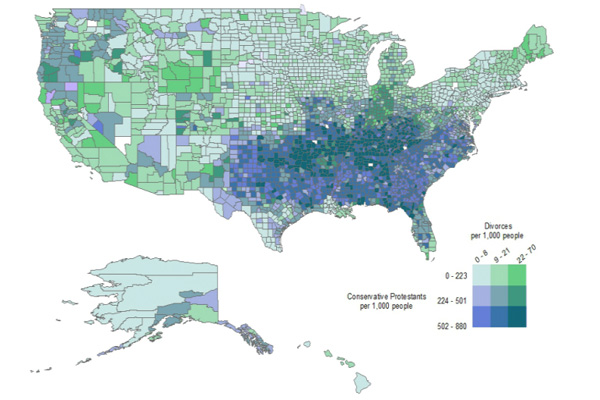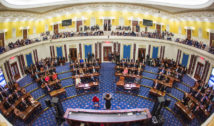
Is There a Link Between Religion and Divorce Rates? The Answer May Surprise You
- By Krista R. Burdine --
- 10 Jul 2014 --

Recent study shows surprising link between religious conservatism and elevated divorce rates
The time has come for churches to update their methods on how to help young people stay married. Sociologist Jennifer Glass, of the University of Texas, has released a demographic study with Philip Levchak of the University of Iowa, which shows that American counties with a higher percentage of conservative Protestants have a higher incidence rate of divorce per 1,000 couples.

Map of U.S. counties by divorce rate. source: Contemporary Families
What Causes the High Divorce Rates?
This correlation has been noted before, but the reason for the link has eluded understanding. Some early explanations addressed by this study include the idea that poverty is a risk factor for divorce; that counties with a higher divorce rate might have a correspondingly higher marriage rate; or areas with a higher divorce rate also culturally have higher rates of domestic violence.
A 1995 Belief and Behavior study from Pennsylvania State University found a tentative link between religious dedication in the home and marital satisfaction, but was unable to show causality. In fact, religious participation was more likely to increase as a result of marital stability than the other way around. This study noted that religion seems to have decreased in its ability to exercise social control. Interestingly, the new study by Glass seems to indicate religion does exert social control, but perhaps not in the positive way one might expect.
The Glass study affirms that poverty and early marriage are indeed part of the equation, but only represent pieces of a bigger problem. According to the study, the cultural climate of a region impacts divorce rates whether or not the marriages involve people who espouse the local norms, in this case conservative Protestant culture. This is due to the influence of the cultural climate on the advice and support of local agencies. Conservative Protestant influence is seen in a bias toward abstinence education over safe sex campaigns, restricted access to birth control and abortions for at-risk young people, a tendency to push marriage as the solution for unplanned pregnancy, and a general distrust of secular education.
Marriage and family advocates admit to surprise over this revelation. W. Bradford Wilcox, director of the National Marriage Project at the University of Virginia, has previously understood that religious involvement can serve as a buffer against divorce, but sees evidence in this study that conservative Protestantism, or at least the culture surrounding it, is apparently an exception.
What Can Religion Do to Lower Divorce Rates?
This information suggests that some stereotypical assumptions about what makes a stable family could be incorrect. Chances are good that governmental policies and social institutions designed to support families may be inadequate or faulty as a result.
The Glass study shows that for every year marriage is delayed through age 30, the chance for avoiding divorce goes up. Additionally, those with more years of education have a better chance of avoiding divorce.
Naomi Cahn and June Carbone, university professors and researchers, have also outlined a set of possible solutions in their book, Red Families v. Blue Families: Legal Polarization and the Creation of Culture, to support American families. This team calls for increased access to contraceptives; a cultural acceptance of the need to combine family with work and education; and make sure kids stay in school so they have the skills they need to take care of themselves and each other.
The conservative church in America actively promotes some of the cultural norms described as ineffective in the UT study. Young women are encouraged to abstain from sex, solve unplanned pregnancy with marriage, and stay in the home to care for the family. Yet as distasteful as it sounds, cultures which vigilantly protect the virtue of the young women are actually some of the places where women are most locked into poverty.
It may be time for governmental policy, especially at the municipal level as indicated in conservative Protestant counties, to take direction from more progressive counties and implement some of these solutions.
But perhaps of greater urgency, conservative churches, and by extension those who consider themselves part of the conservative Protestant culture, need to examine this information carefully. Some of the objections to these solutions involve possibly supporting behaviors contrary to the teachings of the church. However, perhaps by studying the teachings of Jesus a new understanding of helping people could emerge. Jesus met people in their area of need and left them in a better position.
This may involve implementing the solutions presented by the Glass study or in the Cahn and Carbone book, but the payoff promotes the Christian value of solid marriages just as much as (or more than) withholding contraceptive access for religious reasons, encouraging pregnant teens to marry, or keeping young women home with children instead of in the educational system. For the health of families in America, a value espoused by liberals and conservatives alike, the conservative church and surrounding culture have a social imperative to meet young people in their area of need, and leave them better equipped for marriage success.


















